Tigre Bock
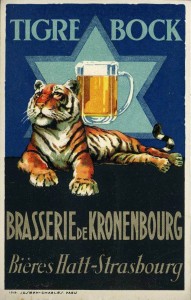 It’s autumn, and in Holland this means: bock beer. All the big Dutch breweries produce their own dark brown variety, some of which are actually quite tasty. So you get a dark Heineken, a dark Amstel, a dark Grolsch. Where this tradition comes from, will be the scope of another article. Right now I’d like to discuss some historical bock beer news. French bock beer is back, courtesy of Kronenbourg. You know, that rather boring French lager.
It’s autumn, and in Holland this means: bock beer. All the big Dutch breweries produce their own dark brown variety, some of which are actually quite tasty. So you get a dark Heineken, a dark Amstel, a dark Grolsch. Where this tradition comes from, will be the scope of another article. Right now I’d like to discuss some historical bock beer news. French bock beer is back, courtesy of Kronenbourg. You know, that rather boring French lager.
French beer? Yes, this wine country also produces beer, and once it was a bock country, just like Germany and the Netherlands. In the 19th century, Paris went into a bock beer craze: after the first German bock surfaced in 1855, soon the entire city yelled: ‘Garçon, un bock!’ While in the Netherlands the dark variety of bock became the norm, France copied the blonde version. According to French standards, it was originally a strong luxury beer. Therefore it was served in smaller glasses, in a size soon also called ‘bock’. There were even ‘bock’-sized bottles. While in Germany and the Netherlands is was a seasonal beer, French breweries, in particular those in Alsace and in Paris, produced it year-round.[1]
Through the years the French bock beer rather devaluated: in 1904 it was the strongest beer type, but by 1938 the original gravity was at not quite so considerable at just 10.6 to 11.6 degrees Plato, and after the Second World War it officially was only 8.48 to 10.04 degrees.[2] It had in fact become the name for weak, bottom-fermented blonde lager, not unlike what’s on offer at Aldi and other cheap supermarkets nowadays. Other beers, pilsener beers, where by then sold in France as ‘bière de luxe’. In the 1970s and 1980s the French bocks quietly disappeared from the market. A last souvenir is the word ‘sous-bock’ for ‘coaster’.
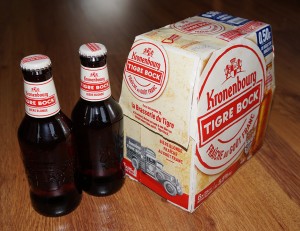 So you can imagine my surprise when I discovered a ‘Kronenbourg Tigre Bock’ in a French supermarket this summer. ‘In the 1920s, the Brasserie du Tigre in Strasbourg gives its name to a beer of well-malted temperament: Tigre Bock’, the package said. Aha, so it’s a historical beer? Okay, I’m interested.
So you can imagine my surprise when I discovered a ‘Kronenbourg Tigre Bock’ in a French supermarket this summer. ‘In the 1920s, the Brasserie du Tigre in Strasbourg gives its name to a beer of well-malted temperament: Tigre Bock’, the package said. Aha, so it’s a historical beer? Okay, I’m interested.
Now I could of course spoon-feed you the entire history of the Kronenbourg brewery, but suffice it to say that the Hatt family, apparently active as brewers in Strasbourg since 1664, moved its brewery in 1850 from the suburb of Krutenau to the then still rural district of Cronenbourg.[3] Next, like everywhere else, Strasbourg breweries switched to bottom-fermenting and started growing, led by the Gruber brewery with its Bock Ale.[4] Nowadays you could do a nice tour around Strasbourg, looking at all those old breweries, of which only l’Espérance, owned by Heineken, is still in operation.
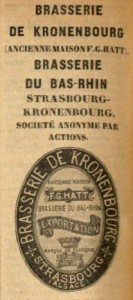 The Hatt brewery in Cronenbourg was originally simply called ‘Brasserie du Bas-Rhin’, Bas-Rhin being the French department in which Strasbourg is located. What beers they made is hard to say, but in 1884 their Paris agent sold their ‘bières blondes et brunes’.[5] By 1896, in any case, they used the brand name Kronenbourg, now with a K, also because Alsace was then part of Germany, and a K looked more German. That was also the reason why the labels in France indicated that it was a ‘bière d’exportation’.[6]
The Hatt brewery in Cronenbourg was originally simply called ‘Brasserie du Bas-Rhin’, Bas-Rhin being the French department in which Strasbourg is located. What beers they made is hard to say, but in 1884 their Paris agent sold their ‘bières blondes et brunes’.[5] By 1896, in any case, they used the brand name Kronenbourg, now with a K, also because Alsace was then part of Germany, and a K looked more German. That was also the reason why the labels in France indicated that it was a ‘bière d’exportation’.[6]
In 1922 the brewery bought the Brasserie du Tigre in Strasbourg. It’s rather confusing, but in French the word ‘brasserie’ originally means ‘brewery’, but it can also indicate a large and chic café-restaurant. In any case the brasserie in Rue du Faubourg National was deemed popular enough to lend its name to Kronenbourg’s beer, which from then on was called ‘Tigre Bock’. The change in name, the dynamic management and the fact that since 1919 Strasbourg was again part of France, resulted in a considerable expansion. By 1933 the brewery produced 250,000 hectolitres, three times as much as twenty years earlier.[7] In 1931, the Brasserie du Tigre itself was completely rebuilt as a large restaurant, with a large skylight in the middle.[8]
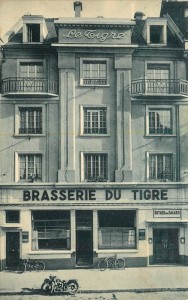 |
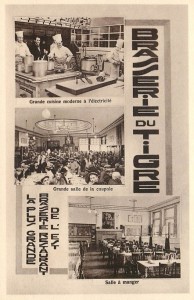 |
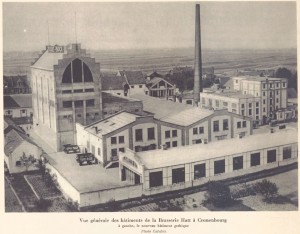 |
In the Second World War the nazis attached Alsace once more to Germany, and the brasserie changed its name into ‘Zum Tiger’. Also the nazis seized control of the Kronenbourg brewery, which gave the actual owner, Jérôme Hatt, the time to read some books on marketing and management. After the war he took swift action, and one of his first deeds was to eliminate the name Tigre Bock. From then on the beer was again called Kronenbourg, and it could start flooding the French market, which they do to this day. In 1952 they created an additional luxury beer called 1664.[9]
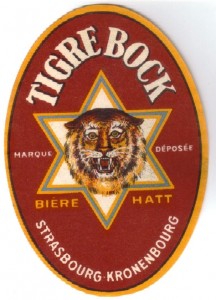 |
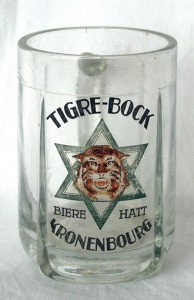 |
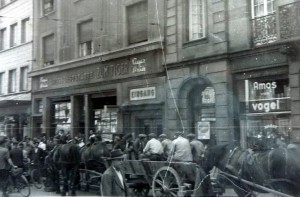 |
And now Tigre Bock is back. It has taken the shape of a 5.5 ABV blonde lager and a 6.3 ABV brown beer. And they actually can do this, because the French regulations that stipulated that bock should be weak, were abolished in 1992.[10] The blonde bock was introduced last year as a draught beer and is available in bottles since this year, and this year the brown bock was added as a bottled beer for pubs and restaurants. Of course all this accompanied by a lot of hoopla about this ‘bière de caractère’, ‘the fresh beer with the frank taste’ and similar slogans.[11]
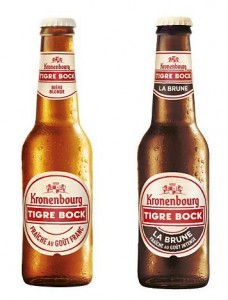 And honestly, I think it’s fun. The blonde beer is nice (though it contains suplhites?!) and the brown version, which I tasted on a terrace in Metz, tastes… like a fine Dutch bock beer. It’s nice that Kronenbourg, which has moved from Strasbourg to an enormous plant near the town of Obernai, is doing something with the bock history of France. It’s hard to say whether they have actually used a historical recipe, but as reasonably basic bottom-fermenters these new bocks will more or less resemble the original ones.
And honestly, I think it’s fun. The blonde beer is nice (though it contains suplhites?!) and the brown version, which I tasted on a terrace in Metz, tastes… like a fine Dutch bock beer. It’s nice that Kronenbourg, which has moved from Strasbourg to an enormous plant near the town of Obernai, is doing something with the bock history of France. It’s hard to say whether they have actually used a historical recipe, but as reasonably basic bottom-fermenters these new bocks will more or less resemble the original ones.
It’s funny if you think about it: it’s the eternal treadmill of beer. In 1947 Tigre Bock was axed as an old-fashioned weak beer, and replaced by the stronger lager Kronenbourg. And now, almost seventy years on, we know Kronenbourg as a boring, watery product that the French pour down their throats without giving it any thoughts. And didn’t Heineken once claim that Kronenbourg was the reason that the French drink so much wine?[12] And so, now Kronenbourg re-introduces its dolled-up Tigre Bock, this time to outdo its lager. You’ve got to admit that there’s some irony to that. Anyway, France is a bock country once again.[13]
[1] http://verlorenbieren.nl/verloren-bieren-37-bock-in-frankrijk/.
[2] J. de Brevans, ‘Bière’, in: Ch. Girard (red.), Analyse des matières alimentaires et recherche de leurs falsifications, Paris 1904, p. 207-242, here p. 212; Revue de fraudes, volume 14 nr. 140 (December 1938), p. 352; Annuaire statistique de la France. Resultats de 1971, Paris 1973, p. 335.
[3] Odile Weiss, ‘Kronenbourg, depuis 1664’, in: Saisons d’Alsace, nr. 60 (juni 2014), p. 88-95, here p. 91.
[4] Described in http://verlorenbieren.nl/verloren-bieren-40-bock-ale/.
[5] Annuarie-Almanach du commerce, de l’industrie, de la magistrature et de l’administration, Paris 1884, p. 875.
[6] Annuarie-Almanach du commerce, de l’industrie, de la magistrature et de l’administration, Paris 1896, p. 1050.
[7] ‘L’Alsace industrielle. La brasserie Hatt à Cronenbourg’, in: La vie en Alsace, 1934, p. 38-42.
[8] Cf. http://www.archi-wiki.org/adresse-5_rue_du_faubourg_national__centre_ville__strasbourg-4382.html.
[9] François Entz, ‘La bière en Alsace’, in: Revue d’Alsace, volume 137 (2011), p. 151-173, https://alsace.revues.org/1212; Weiss, ‘Kronenbourg’, p. 92.
[10] http://www.brasseurs-de-france.com/la-biere/types-de-bieres/classification-et-couleurs/
[11] http://www.kronenbourg.fr/kronenbourg-tigre-bock
[12] Telegraaf 6-6-1990.
[13] Thanks to: Peter Spronk (Bibliothèque des musées de Strasbourg).






Leave a Reply